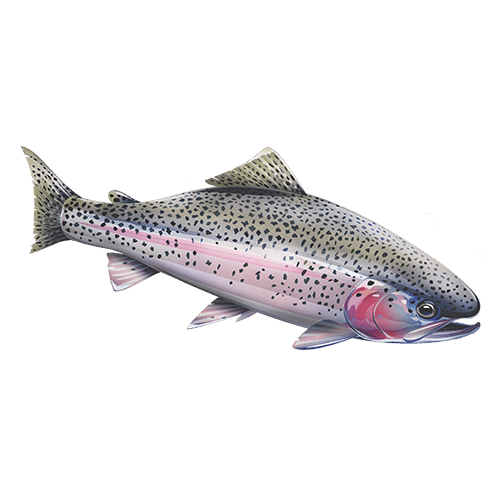How we're working to save them:
Conservation Actions
- Expand projects that increase reliable quantities and quality of cold water habitat.
- Implement management and restoration projects that focus on reconnecting populations of Rainbow trout that are currently separated by barriers and promoting access to diverse habitats to restore genetic diversity.
- Support healthy populations of wild trout for catch-and-release recreational fisheries.
Click here to learn about CalTrout’s overall “Return to Resilience” plan to save California’s salmonids from extinction.
Where to find Eagle Lake Rainbow Trout:
Eagle Lake Rainbow Trout Distribution
Eagle Lake Rainbow trout are found only in Eagle Lake (Lassen County) and its major tributary, Pine Creek. They have been raised in the Mount Shasta and Darrah Springs fish hatcheries and subsequently planted across the United States and Canada due to their tolerance for harsh conditions and rapid growth.
How the Coastal Rainbow Trout Scored:


Characteristics
Eagle Lake Rainbow trout look similar to Coastal Rainbow trout, but have finer scales and the snout is frequently rounded. They have numerous small, irregular spots along their back and fins. They grow quickly and are capable of reaching lengths up to 72 cm (28 in.) and weights of 4.5 kg (10 lbs.).
Abundance
Abundance of Eagle Lake Rainbow trout is not known due to lack of comprehensive studies on their population. Presumably, the numbers depend on the stocking allotment of fish into the lake in a given year from young reared at Crystal Lake and Darrah Springs Fish Hatcheries. Since the population is dependent on hatchery production, it is presumably stable.
Habitat & Behavior
Eagle Lake Rainbow trout are known for their adaptability to both the highly alkaline waters of Eagle Lake and the spring-fed tributaries to Pine Creek where they historically spawned. They are capable of rapid growth due to the abundant food in Eagle Lake, making them desirable as a hatchery strain of fish. They may live up to 11 years of age, and mature slowly, usually at about age three.
Genetics
The most recent genetic evidence suggests that Coastal Rainbow trout invaded Eagle Lake via a historical connection between the Feather River and Pine Creek and became stranded. These fish have two fewer chromosomes (58) than other Rainbow trout.






















 Dams block access to historical spawning and rearing habitats. Downstream, dams alter the timing, frequency, duration, magnitude, and rate of change of flows decreasing habitat quality and survival.
Dams block access to historical spawning and rearing habitats. Downstream, dams alter the timing, frequency, duration, magnitude, and rate of change of flows decreasing habitat quality and survival.